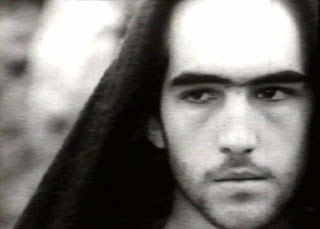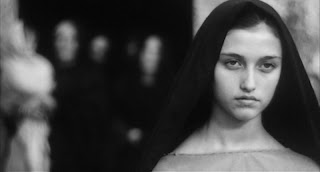February 20, 1966 [The Gospel According to St. Matthew/Il vangelo secondo Matteo]
 The ink's barely dry on the—what? Encyclicals? Bulls?—of the Second Vatican Council, and already it seems the Catholic Church is different. Or maybe it's just the effect of watching Pier Paolo Pasolini's The Gospel According to St. Matthew: Should I write that it was "transfiguring"? His straight-faced Jesus manages theologic math—100% one, 100% the Other—that is, no fooling around, a Mystery of the Church that Pasolini eventually seems to accept, whether it be Joyful or Sorrowful.
The ink's barely dry on the—what? Encyclicals? Bulls?—of the Second Vatican Council, and already it seems the Catholic Church is different. Or maybe it's just the effect of watching Pier Paolo Pasolini's The Gospel According to St. Matthew: Should I write that it was "transfiguring"? His straight-faced Jesus manages theologic math—100% one, 100% the Other—that is, no fooling around, a Mystery of the Church that Pasolini eventually seems to accept, whether it be Joyful or Sorrowful.This Jesus comes straight out of Matthew, simple and almost amateurish—with particular scorn for the rich and an insistence on keeping children at His feet while holding up the eye of a needle in taunting dismissal. He's almost hip, a "Jesus for our time," a secular, self-invented Savior—one deep cat, daddio, next best thing to a copy of Herman Hesse’s Siddartha—without the drag of Mystery. Still, Pasolini leaves in the miracles, performed as physical actions, a nod or a hand raised. It seems the wise man can do mad things.
And one more thing is added, a jolt of memory and recognition: on the soundtrack was Blind Willie Johnson’s “Dark Was the Night, Cold Was the Ground,” which I hadn't heard in years—but have never forgotten, his moaning and his guitar conspiring like angels to take me to the foot of the Cross. Just writing about it, I can hardly take it. The leper approaches Jesus, and I found myself suddenly tearful. How did Pasolini know that, despite my vacillations and fear of God’s silence, I'm moved more than I can express by the curing miracles? Especially lepers—frightening when I was young, like Karloff's Mummy, shambling horrors that could enlist you in their hopeless number with a mere rotted Judas kiss. To hear about saints turning the tables, kissing the leper—Francis comes to mind—is terrible, because I know it's expected of me.
 Oh, boy. This may be more than a mere movie conveyed. But the "problem of pain" of course never goes away; it presses on me like the problem of love—and when they speak together, it's a conspiracy, their cheeks touching, breathing together.
Oh, boy. This may be more than a mere movie conveyed. But the "problem of pain" of course never goes away; it presses on me like the problem of love—and when they speak together, it's a conspiracy, their cheeks touching, breathing together.Hearing Johnson's song about Jesus' burial while on screen He cured the leper made me suddenly imagine that Jesus' cures—all the way to poor Lazarus—were for Him moments of poignant indulgence, opportunities to provide for others what He could not for Himself: rescue from the dark night and the cold ground. And more: Signifiers of the Promise. I will not handle this too much; it's fragile, and I'll need it. But I do love that song, and will not apologize for my tears. The last line of the hymn that Willie simply moans—his audience knew the words—enjoins us to "awake to watch and pray." It is the least we can do; after all, the night is dark, the ground is cold, and we should not leave each other alone.
NOTE: This is one of a number of diary entries that appear here out of order. In reviving this site, I'm including some new entries. —The Editor


May need to see it again. This had left me somewhat dis-satisfied, precisely because of over-de-mystification, because the mystery is real. Scorcese's treatment was closer, as was Dreyer's Joan.
ReplyDelete... and it's been a long time since you made your comment--but I understand how the movie can seem detached. Perhaps it's just the appearance of that song on the soundtrack--maybe I should post it with this. Think I will.
ReplyDelete